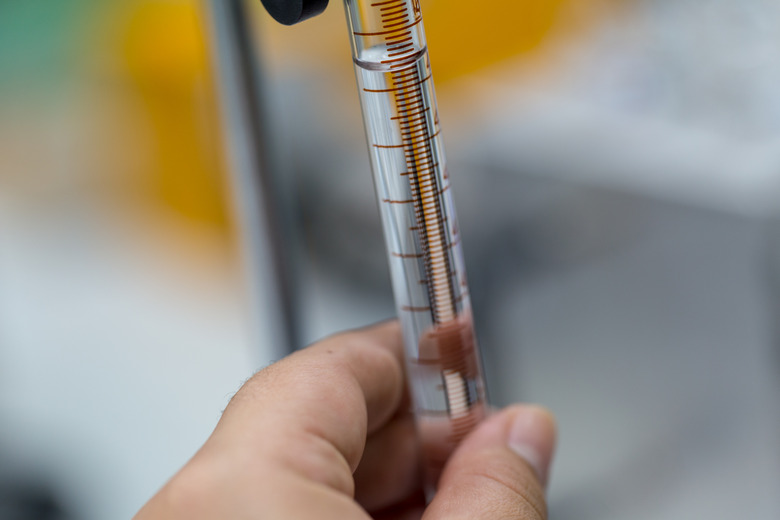How To Calculate Titratable Acidity
Titratable acidity is a total amount of acid in the solution as determined by the titration using a standard solution of sodium hydroxide (titrant). The reaction completetion is determined by a chemical indicator that changes its color at this point. Titratable acidity (in g/100 ml) is typically used to express an acidity of wines that contain several organic acids but mostly tartaric acid. As an example, we will calculate the titratable acidity of the tartaric acid (C4H6O6) solution if its 15 ml aliquot was titrated out with 12.6 ml of the 0.1 molar solution of sodium hydroxide (NaOH).
Step 1
Calculate the molar mass of the acid in the solution as the sum of mass of all atoms in the molecule. Atomic weights of corresponding elements are given in the periodic table of the chemical elements (see resources). In our example it would be: Molar mass (C4H6O6)=4 x M(C)+6 x M(H)+6 x M(O)=4 x 12+6 x 1+6 x 16=150 g/mole.
Step 2
Multiply the volume of the standard solution of NaOH by its concentration to determine the number of moles of the titrant used for the titration. Number of moles=Volume (in L) x molar (mole/L) concentration.
In our example, the volume of the NaOH solution used is 12.6 ml or 0.0126 L. Hence, number of moles (NaOH)=0.0126 L x 0.1 mole/L=0.00126 moles.
Step 3
Write down the chemical reaction the titration is based on. In our example, it is a neutralization reaction expressed as C4H6O6+2NaOH= C4H4O6Na2+2H2O.
Step 4
Determine the number of moles of the acid using the equation in Step 3. In our example, according to that equation, one molecule of the acid reacts with two molecules of NaOH. Thus, 0.00126 moles of NaOH (Step 2) would interact with 0.00063 moles of tartaric acid.
Step 5
Divide the number of moles of the acid (Step 4) by the aliquot volume and then multiply by 100 to calculate the acid amount in 100 ml of the solution. In our example, amount (C4H6O6)=0.00063 moles x 100 ml/15 ml=0.0042 moles.
Step 6
Multiply the acid amount in 100 ml (Step 5) by its molar mass (Step 1) to calculate titratable acidity (in g/100 ml). In our example, titratable acidity=0.0042 x 150=0.63 g/100 ml.
Things Needed
- Calculator
- Periodic table of the chemical elements
Cite This Article
MLA
Writer, Contributing. "How To Calculate Titratable Acidity" sciencing.com, https://www.sciencing.com/calculate-titratable-acidity-5185931/. 13 March 2018.
APA
Writer, Contributing. (2018, March 13). How To Calculate Titratable Acidity. sciencing.com. Retrieved from https://www.sciencing.com/calculate-titratable-acidity-5185931/
Chicago
Writer, Contributing. How To Calculate Titratable Acidity last modified March 24, 2022. https://www.sciencing.com/calculate-titratable-acidity-5185931/
